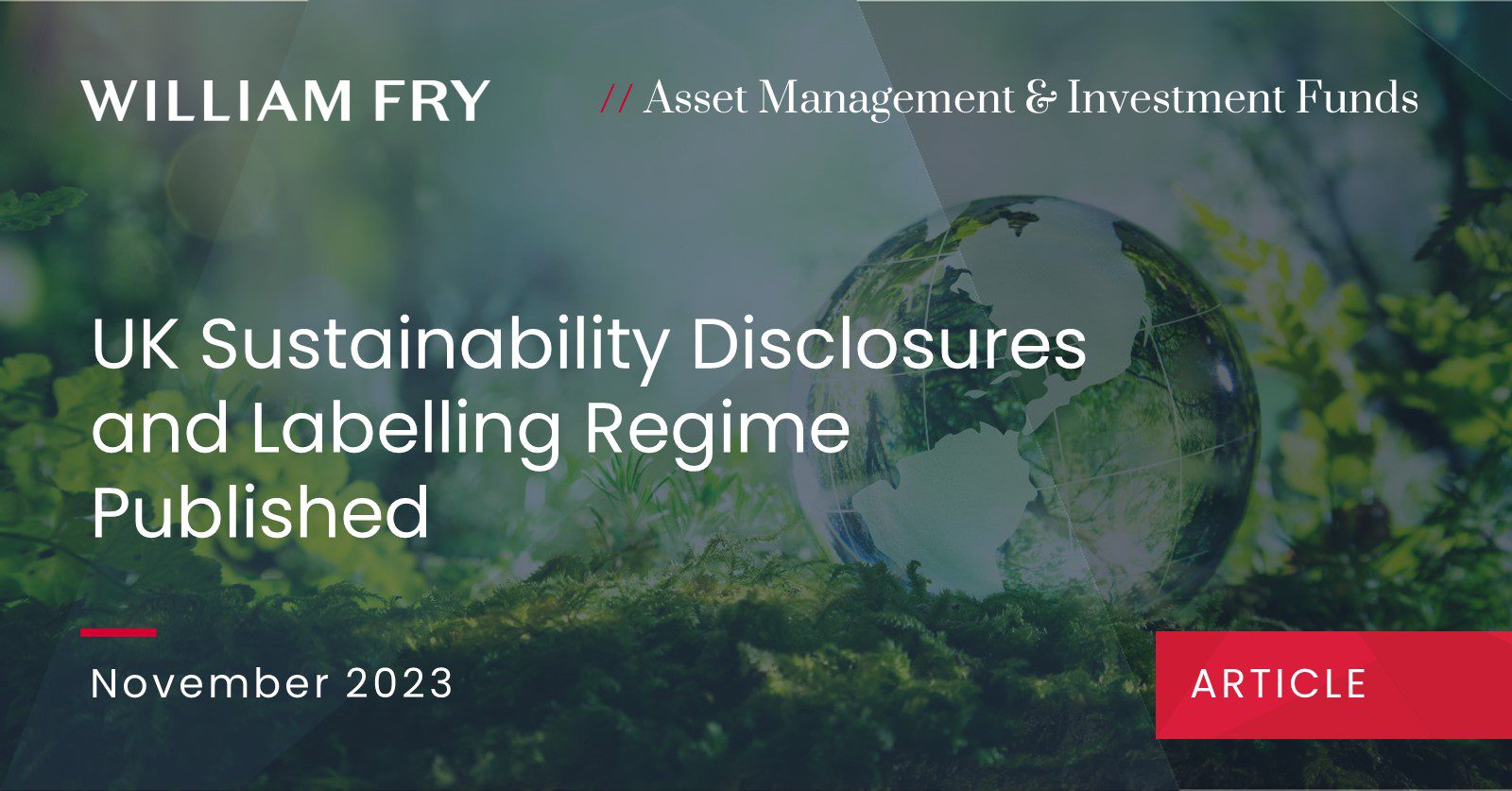On 28 November 2023, the FCA published its long-awaited sustainable disclosures (UK SDR) and product labelling regime in policy statement PS23/16
It includes:
- An anti-greenwashing rule applicable from 31 May 2024 for all sustainability-related claims to be fair, clear and not misleading. The FCA is also consulting on supporting guidance until 26 January 2024.
- Four sustainable product labels of ‘sustainability impact’, ‘sustainability improvers’, ‘sustainability focus’ and ‘sustainability mixed goals’ available from 31 July 2024
- Product-level disclosure rules for labelled products including:
- digital retail investor/consumer-facing sustainability disclosures, applicable from 31 July 2024 (or when the label is first used)
- naming and marketing rules for any use of sustainability-related terms applicable from 31 July 2024 (or when the sustainability-related term is first used)
- ongoing product-level disclosures targeted at institutional investors, applicable from 31 July 2025 (or 12 months after label is first used/provided to eligible clients from 2 December 2025)
- Product-level disclosure rules for non-labelled products with sustainability-related terms in name/marketing including:
- digital retail investor/consumer-facing sustainability disclosures, applicable from 2 December 2024 (or when the sustainability-related term is first used)
- naming and marketing rules for use of sustainability-related terms, applicable from 2 December 2024 (or when the sustainability-related term is first used)
- ongoing product-level disclosures targeted at institutional investors, applicable from 12 months after sustainability-related term is first used
- Entity-level disclosure rules targeted at institutional investors, applicable for firms with AUM >£50bn from 2 December 2025 and to firms with AUM >5bn from 2 December 2026
- Targeted rules for distributors of products to retail investors, applicable from 31 July 2024 for labelled products and 2 December 2024 in respect of the required statement for non-UK funds.
Further details in relation to the above are set out below.
Impact of UK SDR for Irish/non-UK managers and funds
- Non-UK funds/managers not in scope: The UK SDR and labelling regime is only applicable to UK firms and their UK-domiciled funds, although UK firms are required to capture both UK and non-UK funds under management when complying with the entity-level disclosure rules. And UK distributors must notify investors in non-UK funds marketed in the UK, that such funds are not subject to the UK SDR (as set out below).
- Intention to extend scope: While non-UK funds are not currently in scope, the FCA is clear that it intends to extend the scope of the UK SDR and that this is being considered for funds marketed in the UK as part of its work with HMT on the Overseas Fund Regime (OFR) which will succeed the Temporary Marketing Permissions Regime, currently set to expire at end-2025.
- Dual regimes: The most significant immediate impact is perhaps the need, for those operating in both the EU and the UK, to comply with two forms of sustainability disclosures regimes.
The FCA states that it has worked to ensure interoperability with the EU SFDR and has published a comparator of the SDR and SFDR in PS23/16. However, the utility of this exercise is somewhat limited by both the fundamental differences between the two regimes and that neither regime is complete; evolutions of both are currently underway and likely to continue for some time.
The UK SDR is fundamentally a labelling regime, from which a substantial portion of the product-level disclosures are derived. The entity-level disclosures build on existing TCFD-based rules and a further consultation is now open on guidance for the anti-greenwashing rule.
The EU SFDR is a transparency regime only (despite its de facto use as a labelling regime) and is part of, and highly interconnected with, a wider sustainable framework including a Taxonomy of environmentally sustainable activities, sectoral sustainability rules, a corporate sustainability disclosures regime and climate benchmark labels. The EU is also consulting on a new sustainable product labelling regime and the ESMA Fund Names Guidelines for use of sustainability-related terms in the names of UCITS and AIF are expected imminently.
The publication of the UK SDR ahead of the ESMA Fund Names Guidelines and well in advance of the introduction of an EU sustainable product labelling regime (not currently expected to be available until 2026/27), will hopefully inform alignment of the regimes in these respects. Although, the ESMA Fund Names Guidelines are expected before year-end and stricter criteria than their UK counterpart rules (set out below) have been proposed, some of which are highly anticipated to feature in the final form guidelines. See our May 2023 update for further details of the ESMA Fund Names Guidelines.
Key Features of Investment Labels
Sustainability Focus label
To use this label, a product:
- Must have a sustainability objective to invest in sustainable assets identified using a robust, evidence-based standard that is an absolute measure of sustainability;
- Must invest a minimum of 70% of assets to meet that sustainable standard and the remaining assets must not conflict with the sustainability objective;
- Must provide for independent (of the investment process) assessment of the standard being fit for purpose;
- Discretion to choose KPIs but these must measure the sustainability of the assets;
- Stewardship strategy must support assets remaining sustainable/delivering long-term value;
- An escalation plan must be in place for dealing with assets which are not sufficiently achieving the sustainability objective;
- May invest according to themes, provided the above requirements are met.
Sustainability Improvers label
To use this label, a product:
- Must have a sustainability objective to improve sustainability over time and identify assets that have the potential to become sustainable using a robust, evidence-based standard that is an absolute measure of sustainability;
- Must identify the period over which assets are expected to meet that standard, including short and medium-term targets;
- Discretion to choose KPIs but these must measure the assets’ sustainability improvements;
- Stewardship strategy must help accelerate sustainability improvements over time;
- An escalation plan must be in place for dealing with assets which are not sufficiently achieving the sustainability objective.
Sustainability Impact label
To use this label, a product:
- Must have a sustainability objective to achieve a pre-defined positive measurable sustainability impact;
- A specific theory of change must be identified setting out how investment activities and assets achieve the sustainability objective;
- A robust method for measuring and demonstrating positive impact of both assets and investment activities must be identified;
- Discretion to choose KPIs but these must measure the positive impact of both the assets and the investor’s contribution;
- Stewardship strategy must support assets in delivering positive impact;
- An escalation plan must be in place for dealing with assets which are not sufficiently achieving the sustainability objective.
Sustainability Mixed Goals label
To use this label, a product:
- Must have a sustainability objective to invest at least 70% in accordance with a combination of the sustainability objectives for the other labels;
- Must identify and disclose the proportion of assets invested in accordance with any combination of the other labels;
- Must adhere to the requirements (including disclosures) of the other labels.
Naming and Marketing Rules – for products with sustainability-related terms in name/marketing
Sustainability-related terms can only be used in the product names if:
- the product has a label, provided that the term ‘impact’ is only used by those with a ‘sustainability impact’ label; or
- the following are satisfied:
- the product has sustainability characteristics, and the name accurately reflects those characteristics, provided that the terms ‘sustainable’, ‘sustainability’, ‘impact’ and any variation of those terms are not to be used;
- the same types of disclosures as required for a labelled product are produced;
- a prominent website and product-level disclosure statement clarifies that the product does not have a label and why;
- in the case of feeder funds, the product name only includes terms consistent with those used by the master and compliance with (a)-(c) is ensured;
Sustainability-related terms can only be used in marketing materials if:
- the same disclosures and statements as those required when using sustainability-related terms in the name are produced; and
- for feeder funds, the same conditions as when sustainability related terms are used in the name of the product are produced.
Retail investor/Consumer-facing sustainability disclosures – for labelled products and those with sustainability-related terms in the name/marketing
For labelled products and those with sustainability-related terms in the name or marketing materials, firms must produce and keep under review:
- a 2-page (max) clear, concise consumer-facing disclosure on the relevant digital medium used to offer the product, with hard copy available on request
- disclosure must include the product’s sustainability objective, label or clarify that it does not have a label; the investment policy and strategy; relevant metrics; where further sustainability information is available; and for ‘sustainability mixed goals’ labelled products, the proportion of assets invested in accordance with other relevant labels.
Pre-contractual, ongoing product-level and entity-level disclosures targeted at institutional investors
Product-level disclosures for labelled products/those with sustainability-related terms in name/marketing
All labelled products and those with sustainability-related terms in their name/marketing materials must include sustainability information in:
- pre-contractual disclosures, and
- ongoing product-level disclosures in Part B of a sustainability product report annually
For labelled products, the information that must be disclosed is broadly associated with the qualifying criteria for the labels.
For non-labelled products, the pre-contractual and ongoing product-level disclosures must, at a minimum, include information relating to the investment policy and strategy and any relevant metrics.
For the ‘Sustainability Mixed Goals’ label only, the disclosures must include the proportion of assets invested in accordance with each of the relevant labels, and the information required in relation to those labels.
Entity-level annual disclosures for firms with AUM>£5bn
Firms are required to disclose annually on:
- their governance, strategy, risk management, and metrics and targets in relation to managing sustainability-related risks and opportunities and building from the TCFD entity report;
- where firms use labels or sustainability-related terms in their product names and marketing, their resources, governance and organisational arrangements in relation to those products;
Cross-referencing of disclosures made in a group, parent-level or other relevant report, is permitted provided the information is clearly signposted and other cross-referencing requirements are met.
Distributor rules
UK distributors must:
- communicate labels and provide access to consumer-facing disclosures to retail investors;
- keep labels and consumer-facing disclosures up to date;
- notify investors that non-UK funds are not subject to the UK SDR and labelling regime, which notice must be in a prominent place on the relevant digital medium and include a link to the FCA webpage setting out more information or communicated via ordinarily used distribution channels.
Next Steps
The UK SDR and labelling regime will enter into effect in accordance with the implementation timeline set out above. The consultation on guidance for the anti-greenwashing rule is open for comment until 26 January 2024.


